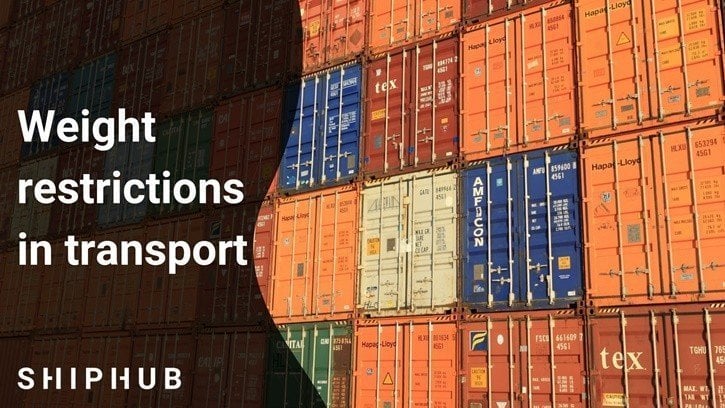Nowadays container transport is the main and most popular form of transport. It allows you to transport goods on long distances between continents. Containers can be carried with different types of transport, which is usually very convenient and profitable for importers. Containers around the world are unified – this means they have the same size and weight limits so that the logistics process is based on the same patterns across the globe. However, we should focus on weight limits that apply to certain types of transport. Below we present weight restrictions in sea, rail, air, and road transport.
Weight restrictions in sea transport
This is the most popular form of transporting goods from China. Sea transport is also the cheapest and most convenient way of transport.
The container is selected depending on the weight and volume of the load. A Chinese manufacturer usually exports and produces goods in a quantity adapted to the type of container. The maximum load weight is 20-24t/per container. Following the SOLAS Convention from 1 July 2016, each container loaded on a ship must have a verified weight of the load. This applies to shipments around the world, not just from China.
Weight restrictions in air transport
There is no faster method of transportation than the plane. Air transport usually carries high value, perishable products, or those that need to be delivered as soon as possible. Unfortunately, a significant downside of this type of transport is the high price. The unit of cargo in air transport is kilograms.
Restrictions
There are restrictions on air transport that are usually related to the size of the plane. Because some of the goods are transported by passenger planes, the height is limited to 158 cm. Products whose height exceeds 158 cm are loaded on freighter planes. There are also special orders, i.e., charter planes – e.g., transport of massive steel constructions that fly a dedicated plane. The limitations are the size of the parcel, which should fit as hand luggage. The standard dimensions of air shipments are usually cartons, loose boxes with a maximum weight of 100 kg, and pallets with dimensions of 120 x 80 x 80 with a weight of 1000 kg.
Weight restrictions in rail transport
Rail transport is a very effective form for the importer. It is associated with a relatively low price, as well as a short time, as transport by rail usually takes about 15 days. The broad-gauge railway transport in railway transport accepts up to 26 tons of goods in a container. However, it should be remembered that weight restrictions on road transport are lower than those in railway transport. Therefore, in order not to incur additional overcharging costs, it is best to use the intermodal transport option. This type of transport ensures delivery of goods using more than one branch of transport.
Rail transport
This is usually used for rail and road transport. Additional swap bodies or car semi-trailers that allow you to transport containers without reloading them are often used.
Weight restrictions in road transport
Restrictions – weight limits for containers in road transport:
- for a 20 ft container maximum permissible gross weight of the goods (including packaging) 21 tons
- for a 40 ft HC container maximum allowable total weight of the products (including packaging) 22 tons
- for the 20 Reefer container maximum allowable total weight of the products (including packaging) 21 tons
- for 40 Reefer container maximum allowable total weight of the products (including packaging) 22 tons
- for container 40 HC Reefer maximum allowable total weight of the products (including packaging) 21 tons
About containers
The weight of the load together with the container’s weight cannot be higher than 24 tons. In the case of transporting a container with a larger weight, the driver should submit a written statement about the exact distance of the transport of goods. In the case of absence of such a declaration or if the distance exceeds 150 km from the terminal, the container will not be released from the terminal and allowed for transport.
Both importer and exporter are advised to familiarize themselves with weight restrictions in transport.





